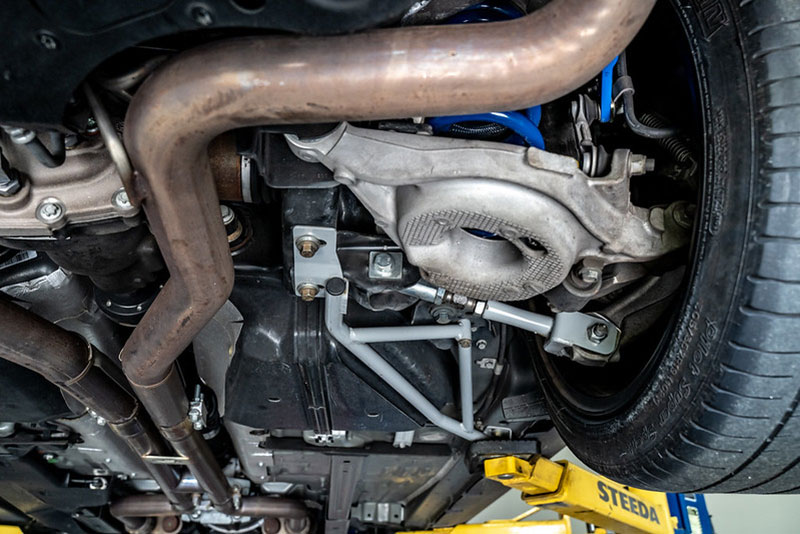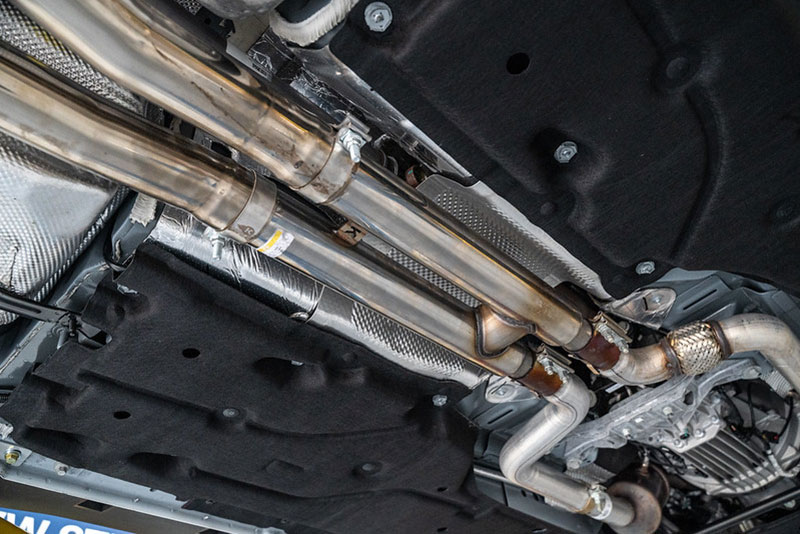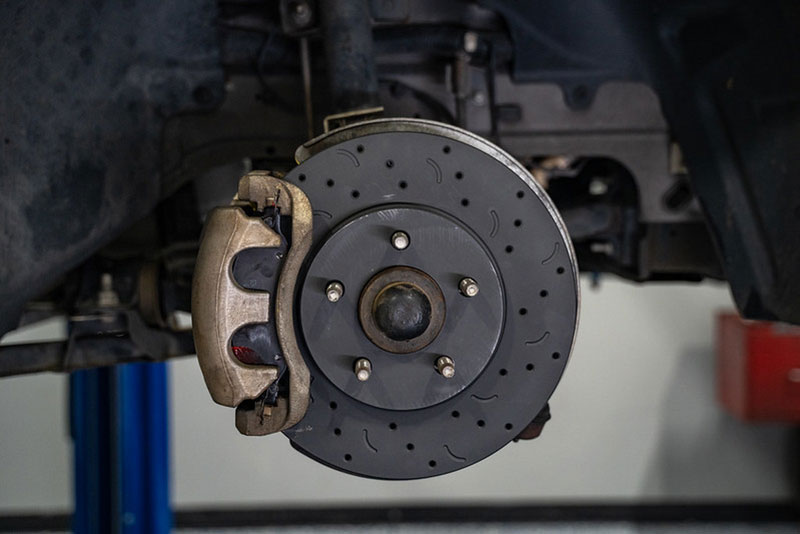Must-Know Ford Mustang Maintenance Tips

Being a Mustang owner comes with its share of joys and responsibilities. While tackling a winding road or laying down rubber is fun, keeping your Ford in peak condition requires dedication and diligence. There’s a lot to focus on, and it can be easy to overlook one or more critical vehicle systems.
With this in mind, we’ve compiled several vital maintenance areas that should be familiar to every Mustang owner. Even if you’re not the DIY type, understanding the details of Mustang upkeep will help you be better informed at the repair shop or in the home garage.
Note that mentioning mileage or a time period is a general guideline. Always consult the owner’s manual to determine Ford’s recommended maintenance schedule for your Mustang. Further, service intervals are based on average driving conditions. If your behind-the-wheel efforts are more “spirited,” then maintenance should occur more frequently.
Find A Tip
Suspension

Suspension upgrades are popular in the Mustang community to improve handling and performance, improve traction on the asphalt, and change the aesthetics and stance of your vehicle.
Your Mustang's suspension endures bumps and vibrations daily. This hard-working system is made up of ball joints, control arms, shocks, struts, springs, sway bars, bushings, and tie rods. While it's calibrated for excellent handling from the factory, suspension components wear over time. Listen for knocking, squeaking, or rubbing sounds that often indicate worn parts.
Catching suspension issues early prevents sudden component failure. This approach also maintains the crisp, controlled handling that Mustang owners demand. Routine alignments can catch issues before they become suspension failures.
Engine Oil
You've heard it before: oil is your Mustang engine's lifeblood. This vital fluid lubricates internal components, reduces friction and wear, seals piston rings, and keeps high temperatures in check. So, monitoring and regularly changing your Mustang's oil is critical.
Most Mustangs take 5-10 quarts of oil, but the owner's manual will specify the correct fill level for your car. An oil change every 5,000 miles is a good general rule for a Mustang, but you may see intervals at 7,500-10,000 miles, depending on the engine and oil type (full-synthetic oil requires less frequent changing).
Be sure to follow Ford's recommendation for the correct oil for your Mustang's engine. Sticking with the proper oil grade ensures sufficient lubrication and helps keep the engine running at peak performance.
In between oil changes, check the oil level monthly at a minimum. Be sure to top it off as needed with the same oil already in the engine.
Exhaust

Mustangs emit a distinctive rumble, courtesy of their exhaust systems fine-tuned for performance. Every element, from manifolds to catalytic converters, resonators to mufflers, and piping to polished tips, plays a crucial role. Continuous exposure to heating, cooling, vibration, and chemical reactions causes internal and external wear on these exhaust components.
Regular inspections of the exhaust system, coupled with essential repairs, can revitalize diminished performance and ensure compliance with emissions regulations, all while maintaining happy neighbors.
Tires
Your Mustang's tires heavily impact braking, handling, ride quality, and safety. Tire maintenance involves checking for adequate tread depth (2/32” is the legal limit in most states, but grip can be compromised at 3-4/32”) and inspecting for damage (cracking, punctures, bulging, and irregular wear patterns).
These regular steps should be accompanied by monthly tire pressure checks and tire rotations every 5,000 to 7,500 miles (in sync with oil changes) or before every track outing for those more “spirited” drivers.
Tires generally last 30,000 to 50,000 miles; less if you like leaving rubber on the pavement. When the time comes, replace tires in full sets of four. Mixing brands, models, tread patterns, or general wear levels compromises performance and safety. The owner's manual outlines original tire sizes and pressures that should be used for your vehicle, but you can upgrade compounds or dimensions within reason.
Brakes

High-performance Mustangs demand robust braking capabilities, especially if you've taken the engine beyond factory specs. Signs of weak brakes include noise, pedal pulsation, pulling, vibration, harder braking, or longer stopping distances. Don't ignore symptoms.
In most cases, fixing Mustang usually involves replacing worn pads or rotors. Contaminated brake fluid could also be an issue. Any brake repairs should be done promptly to ensure safe driving.
You should regularly check the brakes during oil changes. These checks should involve checking pad and rotor wear. Additionally, they should include inspecting for cracked or leaking brake lines. Lubricating parts and adjusting calipers, if necessary, should also be part of the checks.
Replacing brake fluid every two to three years should also be part of the regular maintenance process. Cars participating in any type of Autosport event must flush or bleed the brake fluid before going on the track
Spark Plugs and Ignition Components
Delivering an electric spark to ignite fuel inside cylinders at just the right time allows Mustang engines to run smoothly. Quality spark plugs, wires, coils, and related ignition elements make this sequence possible.
Maintaining spark plugs and ignition components is important for the performance of your vehicle’s engine. Regular Maintenance can lead to optimal fuel economy, engine performance, and emissions compliance.
The recommended replacement schedule for Mustang spark plugs varies significantly (30,000-100,000 miles), depending on the engine and model year. Always use the recommended spark plug specified for your vehicle when maintaining your engine.
Engine Air Filter
An air filter for the engine prevents harmful particles from entering. These particles can damage electronic parts, waste fuel, and cause ignition issues. As such, you'll want to replace it at least every 15,000-30,000 miles. More often if you frequently drive in dusty conditions.
If there's one DIY project that just about anyone can handle, it's replacing the engine air filter. This five-minute job requires basic tools (if any) and minimal skill.
Steering
Your Mustang steering system significantly affects road feel and handling, not to mention the vehicle's safe operation. So, any increase in play or the onset of looseness, vibrations, stiff response, fluid leak, or any strange sounds (like a clunking noise) require prompt attention.
Steering system maintenance should include routine alignment checks, inspections of steering gear boots, and lubrication as needed.
Cooling System
A Mustang’s cooling system doesn’t get much attention until something goes wrong. Numerous components can cause problems: radiator, water pump, thermostat, hoses, pipes, reservoir, belts, and fans. Regular cooling system maintenance helps improve the odds while protecting the engine from excess heat.
A monthly coolant level check will be your most important action, along with topping off the fluid as needed (never open the radiator cap of a hot cooling system). Other steps include checking for leaks and cracks, replacing damaged hoses, and tightening loose fittings. Cleaning any debris that's accumulated on the radiator is also essential. In addition, you'll need to flush the entire system and replace the coolant every five years or 60,000 miles (or more frequently with some Mustang).
Fuel System
Delivering the optimum fuel mixture keeps a Mustang engine running strong for years. Damage or contamination anywhere from the gas tank to the injectors causes poor engine performance and reduced fuel economy. That's why routine fuel system maintenance is essential.
For Mustangs with a replaceable fuel filter, the unit should be swapped every 20,000-30,000 miles. Dirty injectors can also be a problem, which often can be resolved by adding a high-quality injector cleaner into the tank (also consider adding a cleaner periodically as a preventative measure). Being in tune with unusual gasoline smells can catch leaks early, which can be confirmed by a visual inspection or a pressure test by a mechanic.
Exterior Lighting

With so many mechanical systems to concentrate on, it’s easy to forget fundamentals like your Mustang's exterior lighting. While distinctive headlights and tri-bar taillights give this Ford visual appeal, these essentials are more about safety, enabling you to see and be seen.
Fortunately, checking exterior lighting is straightforward. Have a helper watch as you test the low and high headlight beams, fog lights, turn signals, brake lights, backup lamps, license plate lights, side markers, and hazard lights. This is also a good time to inspect covers and lenses for build-up (especially on the headlights) or cracking that may diminish light transmission.
Replace any burned-out bulbs or damaged pieces promptly so you can hit the nighttime roads with confidence. Fortunately, exterior lighting has become a popular upgrade for Mustang owners, so when it does come time for a replacement, you'll have a plethora of options to choose from.
Battery
A failed battery is often at the center of a Mustang that won’t start. After all, the average car battery only lasts for three to five years. Annual testing to measure cranking power and reserve capacity is the best way to avoid getting stranded. Lastly, you'll want to frequently check the battery terminals for corrosion build-up and cable connections for tightness.
Maintenance for the S550 Mustang (2015-2023)
Although the S550 Mustang is relatively new, these cars still require upkeep, especially as the older examples approach a decade on the street. Routine maintenance helps prevent minor problems from turning into major (and expensive) ones.
Whether your S550 is a daily driver or weekend warrior, get a handle on its maintenance status. Review Ford's recommended service schedule for your Mustang and see where things stand. You may have been diligent about oil changes and tire rotations, but does your car need new brake fluid or a coolant flush? What about the air filters for the engine and cabin? It’s not uncommon to forget something on the list.
If you’re behind schedule, put a plan together to get your Mustang back on track. Regular maintenance helps ensure peak performance and preserve value.
Related Articles
-

How To Find Local Mustang Clubs Near You
-

How To Buy A Used Mustang
-

Does Modifying My Car Void My Warranty?


